Welcome, dear riders, to another month of Trolley Posts guaranteed to entertain and inform! This month, we're covering British (and Irish) electric railways big and small, starting with what might be the smallest and oldest operating electric railway in the United Kingdom! Traveling along the crashing southeastern shore of Brighton Beach, Magnus Volk's Electric Railway might seem quite insignificant compared to the giants of interurban transit we've covered on this blog before. While whole railways may have built town centers or establish important freight corridors, Volk's Electric Railway remains just a mere tourist attraction. It is, after all, the oldest operating electric railway in the world (even predating Frank J. Sprague's patented traction motors!). On today's Trolley Tuesday, we hope you do like to be beside the sea-side as we ride along the Volk's Electric Railway!
The Man Behind the Railway
 |
Magnus Volk, a magnanimous Teutonic Titan of electricity and epic beards.
(Royal Pavilions and Museums, Brighton and Hove) |
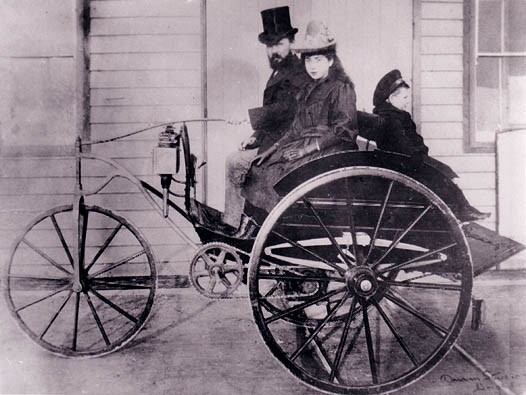 |
He eventually built his own electric car too in 1897, as you do.
(Unknown Author) |
Magnus Volk (1851-1937) was what you might call a "very creative person". Born to a German clockmaker in Brighton, Volk's initial interest was building models alongside his father's business. The finesse and ingenuity that went into clockmaking fueled Volk's creativity, and pretty soon he was making working models of windmills and steamships out of scrapped clock assemblies, earning him the nickname of "Magnus the Dreamer". The dream then became a reality once Magnus' father passed away in 1869, passing the business onto the teenager determined to expand what his father started. Magnus kept the business afloat by making toy telegraph machines and was soon able to hire 20 additional workmen to fill in on clock repair while he experimented with new electrical toys like bells and coils. By eighteen, he was hired on as an electric engineer by the
Corporation of Brighton (BC) and his first electrical installation was in 1883, providing light and heat to the Royal Pavilion estate as well as a massive 200-light (and 200-gaslight) chandelier.
 |
The Banqueting Room of the Royal Pavilion, featuring Magnus Volk's mighty chandelier.
(Royal Pavilion and Museums, Brighton and Hove) |
The Problems With a Prototype Railway
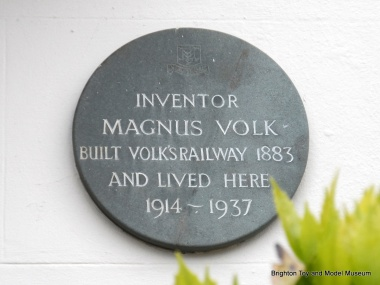 |
A Heritage Plaque at Magnus Volk's second home.
(Brighton Toy and Model Museum) |
 |
The opening day of Volk's electric railway, featuring the little
and quite ramshackle Car No. 1, 1883.
(The Victorian Web) |
With his father's clockmaking business secure and his electric toys making him some serious bank, Magnus Volk began turning to larger industrial applications of his electrical appliances. One of these appliances, a small electric motor, was designed for a firm in London but was rejected, forcing Volk to retool his idea elsewhere and look to his own hometown for answers. As Brighton was already a massively-touristed seaside village, he imagined another novelty to add as a tourist attraction that would proclaim Brighton as a modern, forward-thinking town: an electric railway. His appeal to the BC to build his experimental line along the Brighton seafront was soon granted and he got to work using a small Siemens dynamo and a two-horsepower gas engine for power generation. The route followed a tiny quarter-mile stretch between the Swimming Arch (opposite the Brighton Aquarium) and Chain Pier, laid a stones throw from the water. The tracks were flat-bottom rails laid on lightly-packed sand and crushed ballast, with sea walls erected wherever possible to bridge certain gaps, while the gauge was laid at a slim gauge of two feet.
 |
An 1888 view of the "Volks Marine Electric Railway"'s
original Paston Place station, facing east to the Channel.
(Brighton Toy & Model Museum) |
Interestingly, Magnus Volk's original electrical pickup system did not use any separate powered rail or overhead wire, both ideas that would come into vogue much later. Instead, Volk's initial design used powered rails like a conventional electric train set, providing 50 volts to power the tiny electric motor under the car. The gas engine and dynamo were set at the Swimming Arch, providing ample and steady power, and after a couple of trial runs, Volk opened the
Volk's Electric Railway (VER) on August 3, 1883. Most of the initial riders were certain to see it fail, as many gloomy predictions hounded the project to completion, but to their surprise Volk's little trolley car just started right up and trundled along at a steady 6 miles per hour. By the end of the year, the VER had carried over 300,000 passengers with the little car averaging 50 miles a day shuttling back and forth. Such was the success of the VER that the Brighton Corporation granted Volk an extension east out to Paston Place (which also became the site of Volk's office) in 1884, with a new powerhouse at the Swimming Arch providing a higher 160V DC power supply. However, despite the success, disaster also followed.
 |
This 1937 view shows crashing waves hammering the VER bridge
at Eastern Terrace, showing the power of the Channel on Mr. Volk's railway.
(Brighton Toy & Model Museum) |
Due to the line's location next to the fierce Atlantic Ocean, natural disasters were bound to befall Volk's little railway. Often, violent storms from the coast washed out the entire line (with four such wreckings happening over one summer), and if it wasn't storms, then local merchants and boatmen made it a point to steal ties and equipment to sabotage Volk out of business. Manic street preachers also abhorred Volk's railway by proclaiming that it was a "Devil's contrivance", with electric shocks and wombs damaged by "harsh motion" being the specials of the day. Nevertheless, Volk persevered and had enough public support to ensure that he maintained complete personal control of the railway, no matter the costs needed to keep it open. Various donations from strangers and local newspapers kept the line up, and with his clockmaking and electrical business flourishing, Volk was able to implement improvements on the line such as an offset center third rail to eliminate current leakage caused by collecting power from the wheels by 1886. The added third rail also expanded the track gauge from 2 feet to 2 feet, 8.5 inches, allowing for wider cars and more seats. |
In another artistic view, a car arrives at the Black Rock Station, with the Chain Pier in the background.
The VER was required to pass under the pier, requiring severe grades on both ends of the underpass.
(Volks Electric Railway Association) |
A Bridge Too Far
 |
Rottingdean Beach in 1911, with the B&RSER's landing stage
in the background. The tracks have since been torn up.
(Brighton Toy & Model Museum) |
By 1896, a now-30-something Magnus Volk was looking to update and expand his successful little line east of Paston Place to Rottingdean. While most of the VER was able to contend with crashing seas against its side by using sea walls and fill-ins to cross mighty gaps, it seemed that this gap was a just a bit too far for a tiny two-foot gauge trolley car. Between Paston Place and Rottingdean was an enormous surf shoreline, two miles long and fifteen feet deep during high tide, and any kind of bridge that Volk had in mind was too costly and impractical to implement. In all of his creative ingenuity, Magnus Volk took one more look at the shore and imagined that if he couldn't build a bridge on the shore, maybe he could build... a moving bridge. Thus, in 1894, the
Corporation of Brighton approved Volk's plan to construct the
Brighton & Rottingdean Seashore Electric Railway (B&RSER) through the shallow shores of the English Channel, and it was to be his own crowning achievement (or crowning failure).
 |
The double-track "main line" of the B&RSER at low tide,
showing the concrete sleepers dug into the bedrock.
(James Gray Collection) |
Noting the difficulties of having a railway through the sea being crashed into, Volk dispensed with single rails on either side by constructing two parallel lines of his existing 2-foot, 8.5-inch track gauge on concrete ties attached to the bedrock. This gave the B&RSER a total gauge of 18 feet between its outside rails, and by normal circumstances would make it the widest practical(?) passenger railway gauge in history, but the B&RSER was anything but normal anyway. In order to bridge the gap in electrical conductivity, Volk chose to use a more conventional (and by then, more common) 500V DC overhead wire strung across the water with the earth return being carried by the rails at low tide and the sea at high tide; later, a second return wire was used for ease of maintenance. Power was provided by a powerhouse beneath the Rottingdean Pier, with two 100-horsepower William Sissons and Co. steam engines powering a 50-kilowatt dynamo.
 |
This late-1890s pathé film clip shows the "Pioneer" at work in high tide,
traveling up from Rottingdean Beach to Paston Place.
(Filmoteca de Catalunya) |
 |
Magnus Volk's proof-of-concept model of the Pioneer, now on
display at the Brighton Toy & Model Museum.
(Les Chatfield) |
The single car, named "Pioneer" but commonly known as the "Daddy Long Legs", was similarly oddball in that it resembled more of a Jules Verne "Albatross" on sticks than a standard trolley car. It weighed 45 tons, stood 23 feet tall, and was powered by two GE 25-HP engines powering worm drives on two of the four bogies. Upstairs, the car allowed for riders on two levels, with an enclosed saloon on the bottom and a railinged outdoor promenade on top that also housed the motorman's controls. Due to the unorthodox operation of the line over water, a provision of life preservers and a lifeboat were added by the Corporation of Brighton while a qualified sea captain was stationed aboard at all times. Construction finished on the line by 1896 and by November 28, the line opened to provide wonderful views of the nearby sea cliffs. Unfortunately, Volk's novel idea did not last long as on the night of December 4, 1896, the railway was nearly destroyed after a storm knocked the "Pioneer" over.
 |
A detail of a picture of the "Pioneer", showing off its contact and return trolley poles,
lifeboat, and life preservers atop its wrought-iron frame.
(Urban75) |
 |
The abandoned footings of the B&RSER can still be seen
at low tide in Brighton to this day.
(Engadget) |
Volk managed to salvage the oddball car and rebuilt it two feet higher to better clear the waves, and the line reopened on July 20, 1897. By the end of the year, over 44,000 passengers had experienced Volk's "Sea Voyage on Wheels", but Volk himself never saw much success in his enterprise. The "Pioneer" was noticeably sluggish on high tide and in 1900, new harbor groynes nearby damaged the bedrock that required the railway to close between July and August. The final blow came shortly after this closure when the Brighton City Council told Volk that he would have to divert his railway around a new coastal barrier they were planning. Realizing that this would effectively kill his railway, and having no capital to improve it, Volk abandoned the B&RSER by the end of the year and the entire line was torn up in 1901. Volk's one concession following the failure of his enterprising railway was an extension to the VER from Paston Place to Black Rock, now stretching just over a mile.
Notable Rolling Stock
 |
Magnus Volk's second Car No. 1, emulating the standard horsecars of the time.
The car was 20 feet long and 5 feet 6 inches wide.
(Volk's Electric Railway Association) |
 |
VER Nos. 3 and 4 in "Open Car" formation.
(Volk's Electric Railway Association) |
Between 1883 and 1896, the VER's roster of cars were quite barebones and only five provided services between the Palace Pier and Paston Place. The first No. 1 was Volk's own prototype car with his homebuilt electric motor, a diminutive four-wheel contrivance with a ten-seater body built by William Pollard. This car was scrapped in 1884 as it could not be regauged and was swiftly replaced by a much larger 30-seat saloon car equipped with a Siemens D2 6-horsepower engine. A second 30-seat saloon, No. 2, arrived the next year and both remained stalwart workhorses for the next seven years. In 1892, a pair of 40-seat semi-open cars were built by the VER at Paston Place using 7HP Greenwood & Batley (later 8HP Compagnie Electrique Belge) motors, along with a 30-seat deluxe Saloon. These three cars were Nos. 3, 4, and 5 respectively and worked by a central chassis motor with two driveshafts driving the axles (again, like a model train).
 |
No. 3 (or 4) rebuilt as a semi-open car in the late 1890s.
(Volk's Electric Railway Association) |
 |
VER No. 7, as built in 1901 and looking a lot more deluxe.
(Volk's Electric Railway Association) |
Through the turn of the century, three more 40-seat semi-open cars (with 8HP Belgian motors) were built to provide a roster buffer in case some of the older cars went out of service. Of these cars, Nos. 7 and 8 were the first with side entrance doors instead of end boarding, freeing up boarding times. The last two cars, Nos. 9 and 10, arrived in 1910 and 1926, respectively, the last cars built by the VER works at Paston Place. Through World War II, the replacement No. 1 and No. 2 were both scrapped in June 1948 due to damage in wartime storage, along with the first and second No. 5 (the second behind a 24-seater "winter car" by G. Kelsey of Hove). To replace these gaps, No. 8 (with the side entrance doors) was renumbered "5" and a second No. 8 (an 1898 40-seat open car from Falcon Works, Loughbrough) was obtained from the Southend Pier in 1950. No. 9 (from 1910) became No. 2 after 1948 and No. 10 (from 1926) became the new No. 1.
 |
VER No. 8 (an ex-Southend Pier car) at Brighton, year unknown.
(Volk's Electric Railway Association) |
 |
VER Nos. 10 and 8 meet at one of the passing platforms
on a sunny day, date unknown. No. 10 is wearing the newer
Pullman-inspired livery, while No. 8 is in the former red and cream.
(Volk's Electric Railway Association) |
The last new car to enter service was another No. 9 from Southend Pier, which used two 60-volt milk truck motors to power its axles. When the VER was refurbished in 2000, the two Southend Pier cars were retired and returned to their rightful home for static display, with the second No. 8 going to the Southend Pier Museum and the second No. 9 going to the South Downs Heritage Center in Hassocks. The other renumbered cars gained back their original numbers, leaving Nos. 3, 4, 6, 7, 8, 9, and 10 either in operation or undergoing restoration. The last operating piece of equipment worth mentioning is No. PW, a Motor Rail works diesel used for both maintenance moves and inspection after the powered rail has been switched off for the night.
The Corporation Takes Over
 |
George Herbert Volk.
(Geni.com) |
Magnus Volk remained a constant part of the VER's operation until 1937, when he passed away. His second son (of seven children), George Herbert Volk, grew up alongside the railway and inherited his father's mechanical know-how by becoming a builder of seaplanes, even maintaining a seaplane dock at Paston Place station by 1930. The only real major development around this time was that the railway was cut back 200 yards from the Palace Pier to its current terminus at Aquarium and an outdoor swimming pool at Black Rock cut another 200 yards from the line. By the time Magnus Volk died, a new station at Black Rock was opened and George Herbert Volk now had to find a way to let his father's legacy continue on without him. He needn't think too hard, however, as in April 1940, the Brighton Corporation took over the VER as part of coastal defense preparations. from July 2, 1940, the entire railway closed and the cars were put into storage.
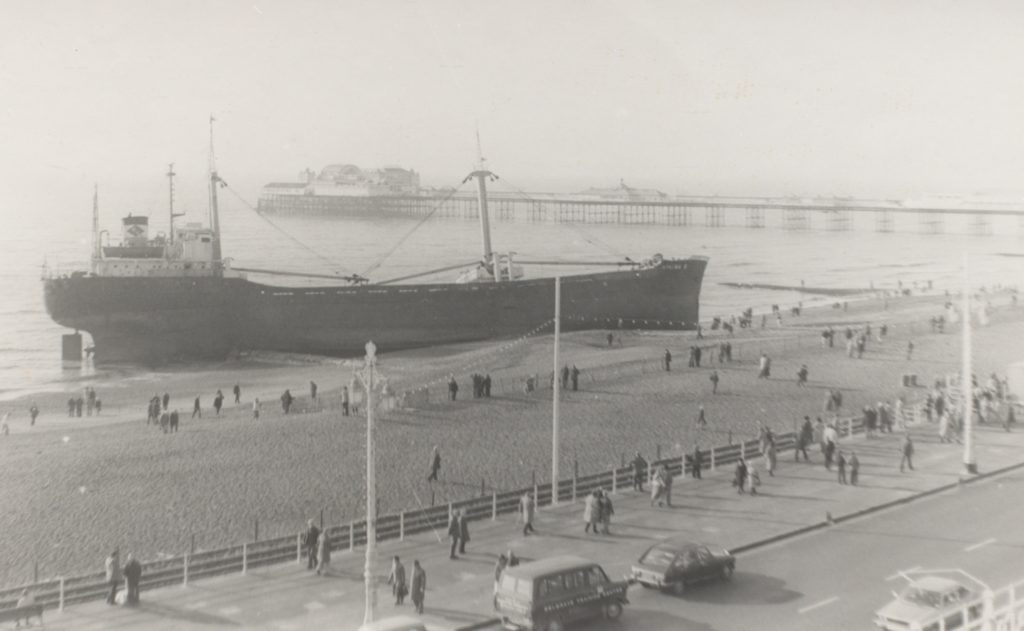 |
The Volk Electric Railway tracks are seen near the beached
MS Athina B in 1980, proving to be quite a lucrative attraction.
(Royal Pavilion and Museums Brighton and Hove) |
After the war, the Corporation began rebuilding the VER using more robust 50-lb/yard rail for the wheels and 25-lb/yard insulated rail for electric pickup. The Black Rock station was also rebuilt as the old building from 1937 had been damaged. Through the next three decades, the VER continued to trundle along as a now-quaint seaside attraction, with declining passenger numbers due to the advent of package holidays making trips to the seaside almost obsolete. The biggest boost in traffic numbers came in the winter of 1980 (which was also the only other time the cars ran in winter after 1954) when the freighter Athina B had beached itself near the Palace Pier. In 1995, the
Volk's Electric Railway Association (VERA) was formed to not only take over operations from the Brighton & Hove City Council, but to also promote the railway to tourists and maintain the equipment. In 2003, this extended to educational outreach thanks to the
Volks Railway Institute of Science and Technology (VRIST) to bring its antiquated tech to the masses.
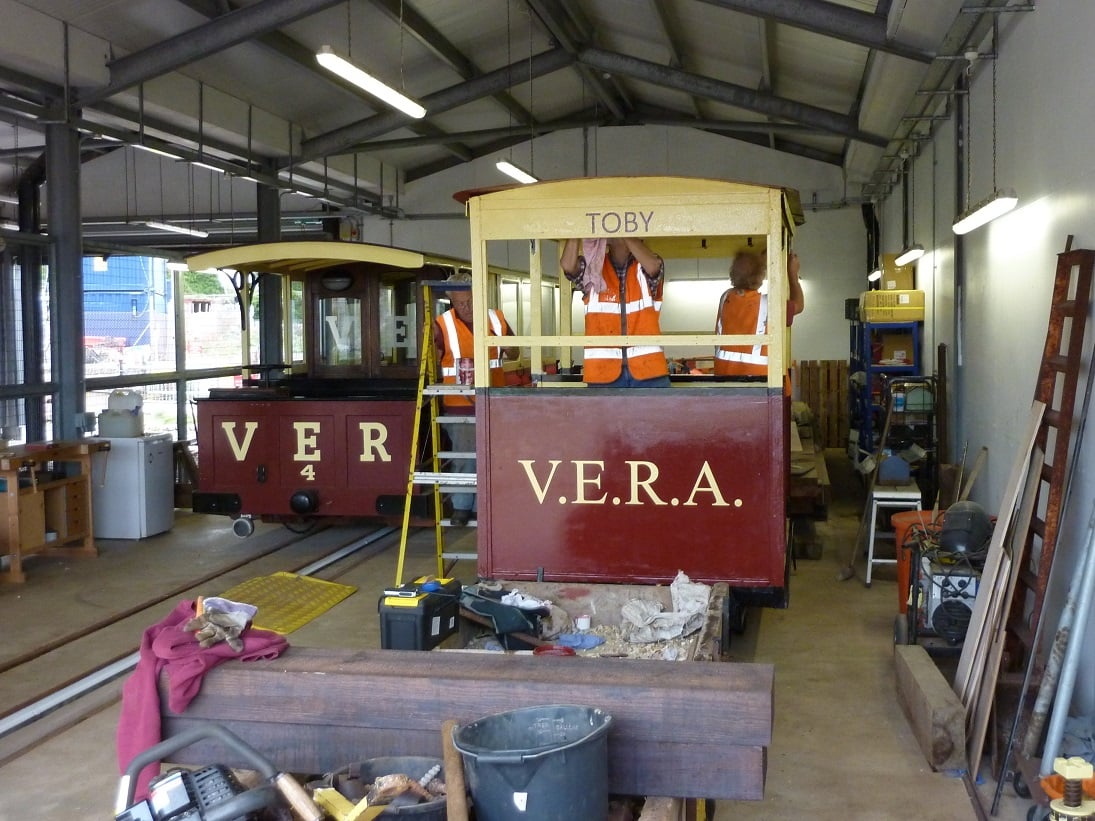 |
The Volks Electric Railway's little "Toby" work tram, lettered for the "Association".
(Volk's Electric Railway Association) |
Current Operations
 |
A revitalized Volks Electric Railway rides again in 2017, following
intense rebuilding thanks to the Heritage Lottery Fund.
The new carhouses are in the background.
(The Railway Magazine) |
Today, the VER continues to run as the world's oldest operating electric railway, with its fleet of seven cars providing a quaint seaside excursion along its one mile of track between the Aquarium (which opened in 1930) and Black Rock. The station formerly known as Paston Place is now "Halfway" and contains a single central island platform surrounded by a passing loop. The once-isolated Black Rock station now sees its purpose as a landing point for the Brighton Marina and has since been rebuilt again when it was demolished in the mid-1990s for a storm drain project. The line also has two more passing loops between both terminals and Halfway, allowing for a 15-minute interval service. Signalling is provided by handheld single-track tokens, which motormen pass to each other every time they clear a passing loop. In 2014, the line underwent an intense period of rebuilding following a Heritage Lottery Fund grant being awarded to the railway to the tune of £1.6 million that provided for restoration of three derelict cars, new carhouse with upgraded maintenance facilities, and a new visitor center, viewing gallery, and ticket office at Aquarium and Halfway. Care of the railway is still handled by the VERA, and may the VER continue on in perpetuity.
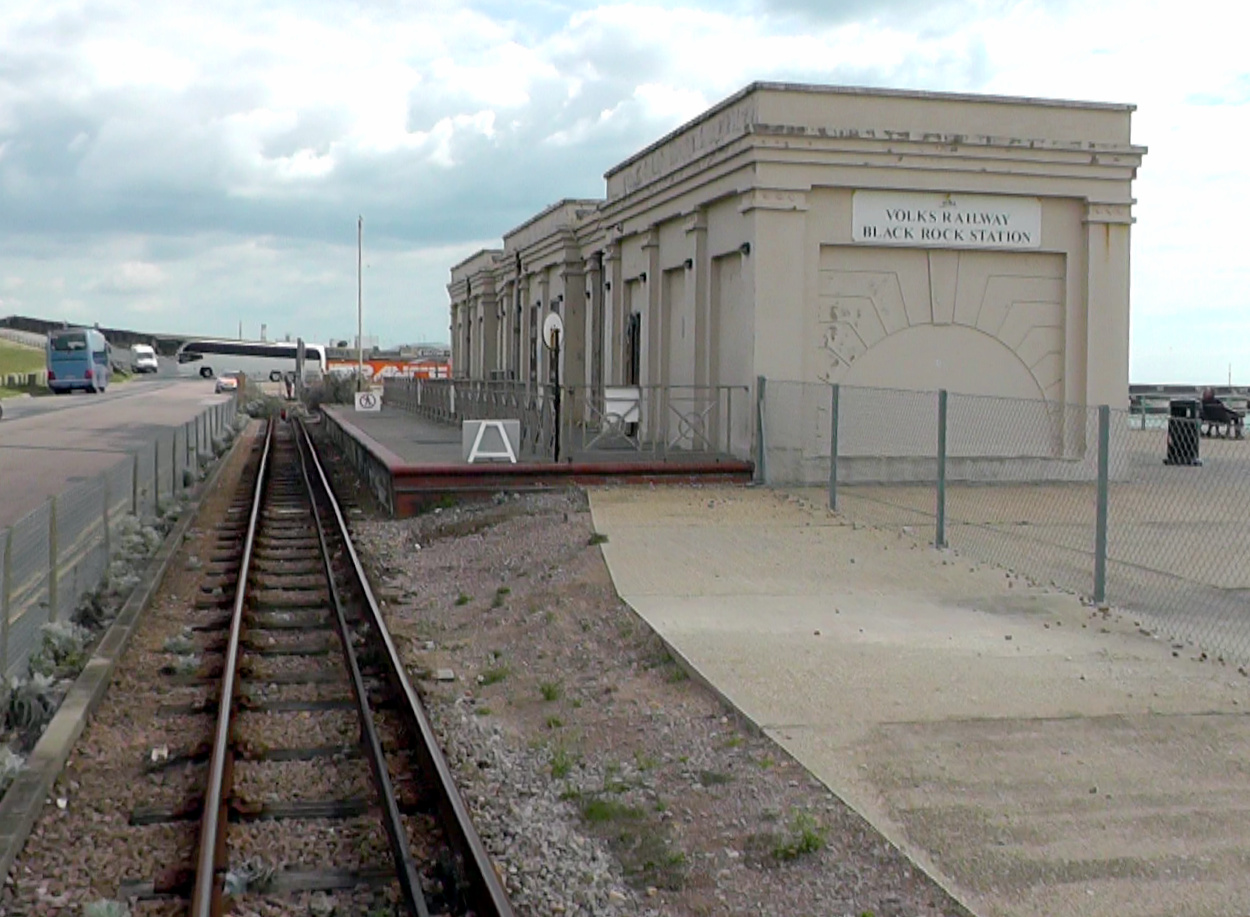 |
The fancy new Black Rock station from 1998, constructed in the Regency Style,
contains a ticket office and toilets inside.
(Narrow Gauge Railways UK) |
Thank you for reading today's Trolley post, and watch your step as you alight on the platform. My resources today included the
Brighton Toy and Model Museum, the
Brighton & Hove City Council, the
Volk's Electric Railway Association of Brighton, and Magnus Volk's own "Volk's Electric Railway, and How It is Worked: Particulars of he Brighton Electric Railway". The trolley gifs in our posts are made by myself and can be found under
“Motorman Reymond’s Railroad Gif Carhouse”. On Thursday, we travel up the Southern Main Line in style on Pullman's Own Brighton Belle! For now, you can follow
myself or
my editor on Twitter, buy a shirt or sticker from
our Redbubble stand, or purchase my editor's self-developed
board game! It's like Ticket to Ride, but cooler! (and you get to support him through it!) Until next time, ride safe!
































No comments:
Post a Comment